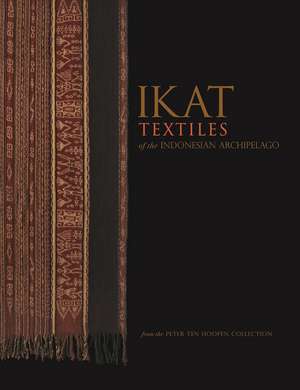Ikat Textiles of the Indonesian Archipelago
Autor Peter Ten Hoopenen Limba Engleză Hardback – noi 2018
Ikat Textiles of the Indonesian Archipelago offers a comprehensive overview of the profusion of ikat styles found across the region and is the first detailed reference book on the subject. Unlike most collectors, both public and private, who typically show a selection of stellar pieces from a limited number of different localities, Peter ten Hoopen shows not just individual masterpieces—though we encounter many in this book—but the culture of the “ikat archipelago.” This is done through the close reading of over two hundred early and emblematic examples from his Pusaka Collection, and by introducing us to the living conditions, beliefs and customs of the various peoples who have created and used them.
The author’s ethnographic approach to collecting allows us to see to where the styles from neighbouring island regions are interwoven—reflecting migration, bridal exchanges, trade, and raiding patterns—and where they stand out by marked individuality. It also allows us to study, not just the people’s finery, but equally their everyday clothing.
Created with scholarly input from a dozen region-specific experts, Ikat Textiles of the Indonesian Archipelago spans the entire arc of the Indonesian archipelago, from Sumatra in the west till the Moluccas in the east. In fact, it reaches beyond Indonesia's borders to include the Malaysian state of Sarawak, and the Democratic Republic of East Timor.
While building on the literature of the “golden years” of ikat research, ten Hoopen offers numerous new additions to the knowledge base, including information on the ikat of a dozen islands and regions not described before. Ikat Textiles of the Indonesian Archipelago also features an extensive selection of photographs, provided by museums, field photographers, and fellow collectors.
The author’s ethnographic approach to collecting allows us to see to where the styles from neighbouring island regions are interwoven—reflecting migration, bridal exchanges, trade, and raiding patterns—and where they stand out by marked individuality. It also allows us to study, not just the people’s finery, but equally their everyday clothing.
Created with scholarly input from a dozen region-specific experts, Ikat Textiles of the Indonesian Archipelago spans the entire arc of the Indonesian archipelago, from Sumatra in the west till the Moluccas in the east. In fact, it reaches beyond Indonesia's borders to include the Malaysian state of Sarawak, and the Democratic Republic of East Timor.
While building on the literature of the “golden years” of ikat research, ten Hoopen offers numerous new additions to the knowledge base, including information on the ikat of a dozen islands and regions not described before. Ikat Textiles of the Indonesian Archipelago also features an extensive selection of photographs, provided by museums, field photographers, and fellow collectors.
Preț: 703.27 lei
Preț vechi: 857.65 lei
-18% Nou
Puncte Express: 1055
Preț estimativ în valută:
134.58€ • 143.90$ • 112.20£
134.58€ • 143.90$ • 112.20£
Carte indisponibilă temporar
Doresc să fiu notificat când acest titlu va fi disponibil:
Se trimite...
Preluare comenzi: 021 569.72.76
Specificații
ISBN-13: 9789881902474
ISBN-10: 9881902479
Pagini: 600
Ilustrații: over 400 color illus.
Dimensiuni: 235 x 311 x 58 mm
Greutate: 3.97 kg
Editura: Hong Kong University Press
Colecția HKU Museum and Art Gallery
ISBN-10: 9881902479
Pagini: 600
Ilustrații: over 400 color illus.
Dimensiuni: 235 x 311 x 58 mm
Greutate: 3.97 kg
Editura: Hong Kong University Press
Colecția HKU Museum and Art Gallery
Textul de pe ultima copertă
Art
Descriere
Ikat Textiles of the Indonesian Archipelago offers a comprehensive overview of the profusion of ikat styles found across Indonesia, and is the first detailed reference book on the subject. Assessing Peter ten Hoopen’s Pusaka Collection from a scholarly point of view, it is worth acknowledging how it illustrates the concept of ‘unity in diversity’, which the young state of Indonesia chose as its motto upon independence. Here, the interwoven-ness of styles from neighbouring island regions matter, as do their marked individuality and idiosyncrasies. Moreover, it allows for the study not just of the people’s finery, but of their everyday clothing. An ironic illustration of the effect of this collecting method comes from Ili Mandiri on Flores. As its dark red bridewealth sarongs have been prized and venerated by the local population, this is what most sophisticated collections have aimed to obtain. The simple but lovely indigo sarongs for everyday use have been almost entirely ignored by collectors; hence, they nearly always end up worn to shreds and very few survive. What knowledge is conserved about ikat textiles and their use in the Indonesian archipelago consists primarily of the records of missionary and scientific fieldwork, predominantly compiled by non-Indonesians. The coverage is thin—many weaving regions are covered by only one or two sources, and several regions have never been studied in detail. Much traditional knowledge is being lost, especially in the more remote island regions in the Indonesian archipelago, which require a concerted effort if any trace of their culture is to survive. UMAG hopes to contribute to the broader project by means of this publication, which shows ikat culture through a close reading of examples from over fifty weaving regions and an introduction to the conditions, beliefs and customs of the various peoples who have created and used them.
